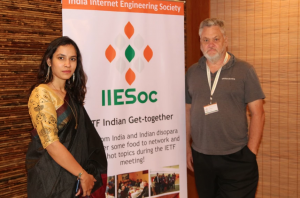
In the lead up to last month’s Internet Engineering Task Force meeting in Singapore, IETF 106, the India Internet Engineering Society (IIESoc) held its third annual Connections conference in Kolkata, India.
This pre-IETF event aims to increase participation in IETF discussions from the Asia Pacific region, specifically India.
Read: Taking the IETF to the people
Like the years before it, this edition of Connections had four technology tracks across two days; the themes of which — IoT, security, routing and research — were chosen with the audience and location in mind, given Kolkata is a major research hub in India. As such, there was record participation, with a large number of local students attending the event, many of whom were excited to learn about, discuss and contribute to the work being considered in the IETF and how they can contribute to this group.
The importance of being involved
A feature of past Connections events has been the participation of IETF working group chairs and RFC contributors attending en route to the impending IETF conference. This year was no different and we were grateful to have former IETF chair, Fred Baker, who presented the keynote and shared his journey at the IETF during the meet and greet session.
The number one lesson that I took from he and other long-time IETFers was to start with the mailing lists and find your niche in the community. The IETF covers so many different technologies and protocols, you’ll be overwhelmed if you try to follow it all.
One presentation that received a lot of attention was that of local researcher Bimal Roy, who shared his insights about the open areas in future research, consolidating the current issues in Internet communication. He too, talked about the importance of participants, — no matter their experience — being engaged with the global Internet community through mailing lists and attending forums such as the IETF. This led to an interesting discussion on getting support to attend IETF and other related events.
Usually, employers fund attendance but it is a challenge to prove the significance of participation in standards development for many small and medium-sized companies. Fortunately, the IETF is held at least once a year in the Asia Pacific region, which makes it possible to self-fund travel and accommodation. There are also fellowship opportunities provided by the Internet Society. Several previous fellows shared their experiences and how they first got involved in the IETF.
Paul Wilson from APNIC also highlighted how APNIC and other RIRs are helping in this area through fellowships to regional events. As a previous APNIC fellow, I can attest that the opportunity is really rewarding and has opened so many doors for my career, in both technical and non-technical areas. I’ve found that being involved improves your chances to connect with and ask questions of the experts and find solutions to technical problems in your current work.

As an IoT developer, my interests have always focused on the development of protocols but attending APNIC 48 exposed me to the policy areas of the Internet which is important to understand, particularly surrounding the allocation of Internet resources. Following my APNIC fellowship, I successfully organized a Youth Internet Governance Forum aligned with India Internet Week, which gathered huge traction from the India youth community.
Empowering the next generation
To ensure continuous engagement with the community, IIESoc holds smaller events throughout the year, which focus on continuous engagement with standards development. One such event is ‘RFCs We Love’, where technical community members gather to share information about their favourite RFCs. All the events are broadcast live and also uploaded to YouTube to cater to remote attendees.
IIESoc is also inviting the next generation of leaders to contribute and elevate their knowledge through volunteer community engagement and taking the RFCs We Love event to every university working on research and development.
As a result of the continued efforts of IIESoc, we are seeing participation from new members of the industry. Venkatram, who manages the India R&D Team at Syntiant Corp. says that Connections helped him to share the challenges he and his team face in productization due to a lack of standards. Also, referring to standards from time to time has helped him and his team to complete the development cycle more efficiently with fewer iterations, enabling earlier product launches.
Praneet Kaur is an IoT developer working for Smartron, an Indian startup.
The views expressed by the authors of this blog are their own and do not necessarily reflect the views of APNIC. Please note a Code of Conduct applies to this blog.
